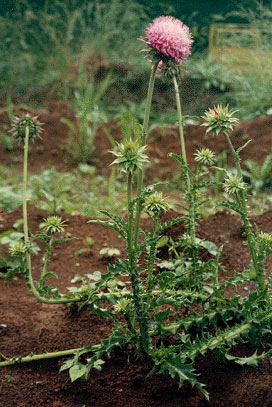
Carduus nutans is a biennial plant in the daisy and sunflower family Asteraceae with the common names musk thistle, nodding thistle, and nodding plumeless thistle. It is native to regions of Europe, Central Asia, and North Africa, where it is a scattered pasture plant. The musk thistle has been declared as invasive in North America, Australia, New Zealand, and South Africa.
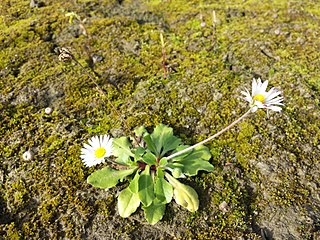
Bellis perennis, the daisy, is a European species of the family Asteraceae, often considered the archetypal species of the name daisy. To distinguish this species from other plants known as daisies, it is sometimes qualified or known as common daisy, lawn daisy or English daisy.

Digitalis purpurea, the foxglove or common foxglove, is a toxic species of flowering plant in the plantain family Plantaginaceae, native to and widespread throughout most of temperate Europe. It has also naturalized in parts of North America, as well as some other temperate regions. The plant is a popular garden subject, with many cultivars available. It is the original source of the heart medicine digoxin. This biennial plant grows as a rosette of leaves in the first year after sowing, before flowering and then dying in the second year. It generally produces enough seeds so that new plants will continue to grow in a garden setting.
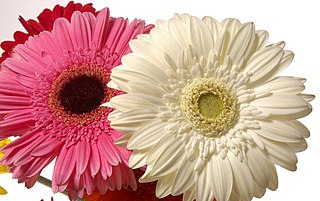
Gerbera L. is a genus of plants in the Asteraceae (Compositae) family. The first scientific description of a Gerbera was made by J. D. Hooker in Curtis's Botanical Magazine in 1889 when he described Gerbera jamesonii, a South African species also known as Transvaal daisy or Barberton daisy. Gerbera is also commonly known as the African daisy.

Ipomoea purpurea, the common morning-glory, tall morning-glory, or purple morning glory, is a species in the genus Ipomoea, native to Mexico and Central America.

Xerochrysum bracteatum, commonly known as the golden everlasting or strawflower, is a flowering plant in the family Asteraceae native to Australia. Described by Étienne Pierre Ventenat in 1803, it was known as Helichrysum bracteatum for many years before being transferred to a new genus Xerochrysum in 1990. It is an annual up to 1 m (3.3 ft) tall with green or grey leafy foliage. Golden yellow or white flower heads are produced from spring to autumn; their distinctive feature is the papery bracts that resemble petals. The species is widespread, growing in a variety of habitats across the country, from rainforest margins to deserts and subalpine areas. The golden everlasting serves as food for various larvae of lepidopterans, and adult butterflies, hoverflies, native bees, small beetles, and grasshoppers visit the flower heads.

Echinacea purpurea, the eastern purple coneflower, purple coneflower, hedgehog coneflower, or echinacea, is a North American species of flowering plant in the family Asteraceae. It is native to parts of eastern North America and present to some extent in the wild in much of the eastern, southeastern and midwestern United States as well as in the Canadian Province of Ontario. It is most common in the Ozarks and in the Mississippi/Ohio Valley. Its habitats include dry open woods, prairies and barrens.

Eucomis comosa, the pineapple flower, pineapple lily or wine eucomis, is a species of flowering plant in the asparagus family Asparagaceae. A deciduous bulbous perennial used as an ornamental plant, it is endemic to South Africa. The white to purple flowers appear in summer and are arranged in a spike (raceme), topped by a "head" of green leaflike bracts.

Verbascum blattaria, the moth mullein, is a flowering biennial plant belonging to the figwort family Scrophulariaceae. A native of Eurasia and North Africa, it has naturalized in the United States and most of Canada since its introduction and has become an invasive species there. It has been declared a noxious weed by the state of Colorado.
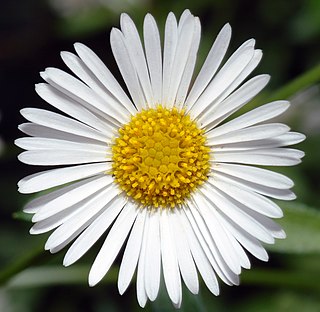
Erigeron karvinskianus, the Mexican fleabane, is a species of daisy-like flowering plant in the family Asteraceae, native to Mexico and parts of Central America.

Berkheya is a genus of flowering plants in the family Asteraceae. It is distributed in tropical Africa, especially in southern regions. Of about 75 species, 71 can be found in South Africa.

Corymbium is a genus of flowering plants in the daisy family comprising nine species. It is the only genus in the subfamily Corymbioideae and the tribe Corymbieae. The species have leaves with parallel veins, strongly reminiscent of monocots, in a rosette and compounded inflorescences may be compact or loosely composed racemes, panicles or corymbs. Remarkable for species in the daisy family, each flower head contains just one, bisexual, mauve, pink or white disc floret within a sheath consisting of just two large involucral bracts. The species are all endemic to the Cape Floristic Region of South Africa, where they are known as plampers.

Arctotis fastuosa, called Monarch-of-the-veld, is a species of African plants in the family Asteraceae, native to Namibia and South Africa. It has become naturalized on roadsides and in vacant urban lots in southern California.

Felicia echinata, commonly known as the dune daisy or prickly felicia, is a species of shrub native to South Africa belonging to the daisy family. It grows to 1 m (3.3 ft) high and bears blue-purple flower heads with yellow central discs. In the wild, it flowers April to October.
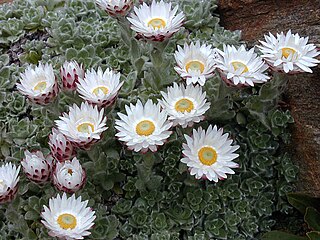
Helichrysum milfordiae, the Milford everlasting, is a species of flowering plant in the family Asteraceae, native to South Africa. Growing to 10 cm (3.9 in) high by 50 cm (20 in) wide, it is a mat-forming evergreen perennial with silver-grey leaves arranged in tight rosettes, producing solitary daisy-like flowers in spring. The white flower bracts have pink undersides which are prominent in bud.

Felicia josephinae is a roughly hairy annual herbaceous plant of 15–20 cm (6–8 in) high, that is assigned to the family Asteraceae. It branches near its base, and has few leaves along its stems. The lower leaves are set oppositely, inverted lance-shaped, relatively large at 3–7 cm long and ⅔–1¼ cm wide, and soon withering, while the higher ones are smaller and relatively narrower. In the axils of the leaves grow flower heads of 7–8 mm wide on stalks of up to 5 cm (2.0 in) long, topped with an involucre of about 5 mm (0.20 in) high and 4 mm (0.16 in) wide, consisting of eleven to thirteen bracts in two rows with bristles near the tip, eight to nine white or cream-coloured ligulate florets surrounding fourteen or fifteen deep purple disc florets. Flowers can be found in September and October. The species is an endemic species that can only be found in a small area along the west coast of the Western Cape province of South Africa.

Felicia heterophylla is a roughly hairy annual plant in the family Asteraceae. It has alternate leaves of 1–5 cm long with an entire margin or few inconspicuous teeth. The flower heads are set individually at the tip of its stems, and contain a whorl of purplish blue ray florets around a center of blackish blue disk florets. Flower heads appear in winter and spring. It is called true-blue daisy in English and bloublomastertjie in Afrikaans. It is an endemic species that only occurs in the Western Cape province of South Africa.

Mairia coriacea is a perennial plant assigned to the family Asteraceae. It has broad, tough and leathery, evergreen leaves. These have a narrowed foot and an entire margin or a few shallow, irregular teeth. They grow in a rosette directly from the rootstock. The plant produces flower heads with one whorl of white to mauve ray florets around many yellow disc florets, with one or few on top of a dark reddish, woolly stalk. Flower heads appear after the overhead vegetation burnt down, often destroying the leaves in the process. It can be found in the southern mountains of South Africa's Western Cape province. It is called leather leaves in English.

Mairia petiolata is a tufted, variably hairy, perennial plant of up to 15 cm (6 in) assigned to the family Asteraceae. Its leaves are in a ground rosette, and have a stalk of mostly 2–5 cm long and an inverted egg-shaped to elliptic, 61⁄2–9 cm (2.6–4.6 in) long and 2–3 cm wide leaf blade, with a toothed margin. It mostly has two flower heads at the tip of the branches of each erect, dark reddish brown scape. The flower heads have a bell- to cup-shaped involucre that consists of 20–24, purplish, overlapping bracts in 3–4 whorls. These protect 12–16 pink, ray florets, surrounding many yellow disc florets. This species was only seen flowering once, in December. It is known from one location in the Langeberg, Western Cape province of South Africa.

Mairia hirsuta is a tufted perennial, herbaceous plant of up to 40 cm high, that is assigned to the family Asteraceae. Most of its narrow to broad elliptic or inverted egg-shaped leaves are part of the basal rosette, have margin that is rolled under, with rounded or pointy teeth or with some peg-like extensions, lightly woolly on the upper surface and densely woolly on the underside, but always the green remains visible. Flower heads have been found from July to November, mostly after a fire or when the soil has been disturbed. The species can be found in the southern mountains of the Western Cape province of South Africa.




















